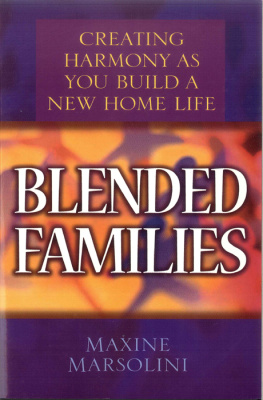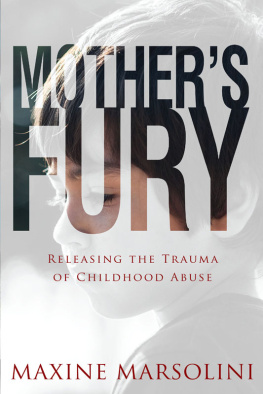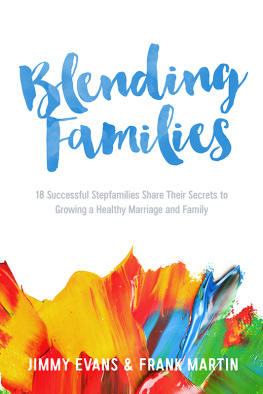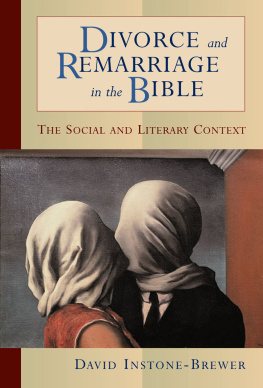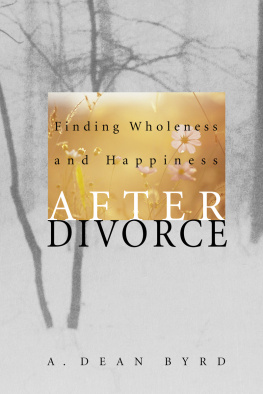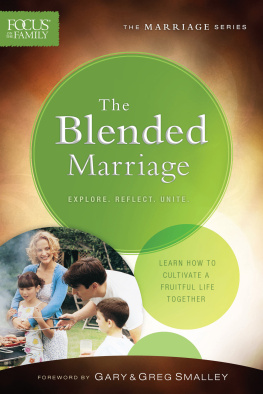BLENDED
FAMILIES
BLENDED
FAMILIES
CREATING
HARMONY AS
YOU BUILD A
NEW HOME LIFE
_______________
MAXINE MARSOLINI
M OODY P UBLISHERS
CHICAGO
2000 by
M AXINE M ARSOLINI
All rights reserved. No part of this book may be reproduced in any form without permission in writing from the publisher, except in the case of brief quotations embodied in critical articles or reviews.
The characters you find in the pages of this book are real. In some cases the names and certain details have been changed to protect the privacy of the individuals involved.
All Scripture quotations, unless indicated, are taken from the Holy Bible: New International Version. NIV. Copyright 1973, 1978, 1984 by International Bible Society. Used by permission of Zondervan Publishing House. All rights reserved.
The NIV and New International Version trademarks are registered in the United States Patent and Trademark Office by International Bible Society. Use of either trademark requires permission of International Bible Society.
Scripture quotations marked ( KJV ) are taken from the King James Version.
Scripture quotations marked ( NASB ) are taken from the New American Standard Bible, Copyright 1960, 1962, 1963, 1968, 1971, 1973, 1975, 1977, 1995 by The Lockman Foundation. Used by permission.
Scripture quotations marked ( TLB ) are taken from the Living Bible 1971. Used by permission of Tyndale House Publishers, Inc., Wheaton, IL 60189. All rights reserved.
We hope you enjoy this book from Moody Publishers. Our goal is to provide highquality, thought-provoking books and products that connect truth to your real needs and challenges. For more information on other books and products written and produced from a biblical perspective, go to www.moodypublishers.com or write to:
Moody Publishers
820 N. LaSalle Boulevard
Chicago, IL 60610
ISBN: 978-0-8024-3056-4
9 10 8
Printed in the United States of America
With thanks to my husband, Charlie,
and to our many friends for their encouragement.
I dedicate this book, with love, to our children
Andrea, Mike, Felicia,
Grace, Charles, Sabrina,
and Deborah,
acknowledging the pain divorce
has inflicted upon their lives.

CONTENTS

INTRODUCTION
T wenty-four years ago I found myself caught off guard by the uniqueness of the blended home. Divorced and raising two children, I again stood in a chapel repeating lifelong vows before a clergyman. I was linking my life to a man who was already the father of three children. His prior marriage, like mine, had ended in divorce. We both thought this new marriage would be different. After all, we were in love.
At that time the emotional high of fresh romance kept us from realizing the complexity of the journey we were embarking upon as we uttered the simple words I do. Within days we were facing reality with a clearer vision. Not only did we as newlyweds face transition in every arena of life, but so did every member of our family. Unwanted change paid frequent visits, clothed in unexpected emotional pain, too often causing victory in our home to seem unattainable. It wasnt long before we were struggling with rejection, blame, rage, and jealousy, as well as alcohol to deaden the pain, competition between siblings, and surprises from ex-spouses.
Blended familiesfamilies formed as the result of divorce and remarriage, with children to nurturerepresent the most difficult form of family life people attempt to live out today. And our numbers are increasing.
More than half of Americans today have been, are now, or will eventually be in one or more step-situations during their lives. What had happened to this second chance at happily ever after? Why didnt these couples dreams come true? Why were husbands and wives throwing in the towelagain? Does it really matter to the overall population how these individuals learn to manage family life? Lets explore that thought further.
In June 1998 the ABC News program 20/20 aired a special on stepfamilies. Hugh Downs noted that its projected that in just seven years, more Americans will be living in stepfamilies than in traditional families, which makes our next report critically important. A significant portion of our population is the new American family, Hugh continued, better defined as the blended family. It is ludicrous to believe our lives wont be touched by blended families. We need to take their needs seriously. They are in our workplaces, our churches, and our neighborhoods. They The blended families addressed within this book fall into one of six formations:
1. Both the husband and wife have divorce histories. At least one has young children to nurture. Most often both have children in formative stages.
2. One spouse has been divorced and has children, and the other spouse has not previously been married.
3. The marriage of a divorced man or woman (with or without children) to an individual who has broken off a cohabiting relationship, having never been married, yet parenting children. This man or woman is feeling the emotional upheaval of a severed relationship but is without legal documents. The child still has a nonresident birth parent imposing influence on the family.
4. A divorced individual (with or without children) remarries a previously unwed mother or father. Perhaps parenting is the result of a teen pregnancy, abandonment of the child, or excessive promiscuity where the parentage of the child is perhaps unknown.
5. The remarriage of a parenting, previously divorced husband or wife to a partner who has lost a mate to death and is still rearing children.
6. The blended family brought about by a spouse becoming involved in an extramarital affair. This particular couple perhaps had no original history of divorce or remarriage, but suddenly found themselves in the midst of blended family issues as the result of promiscuous actions resulting in the birth of a child belonging to one of the spouses. The couple feels the tug on their heartstrings and feels responsible as parent figures.
In all but one of these blended family formations are two common threads. There is at least one personal history of divorce and remarriage, and there are already children to care for. As these two family units come together they often find a collision course rather than a rose-strewn path. It is crucial to the survival of these families that they learn how to bring union out of diversity. Each family member needs to feel respected, loved, and included. By using effective life management skills, the couple can put their new marriage on the path to a happy ending.
When the wedding bells stop ringing and day-to-day living begins in the ready-made family, the impact of two separate family structures begins to occur. As the differences are exposed short tempers often follow. The parents prior intimate relational histories suggest that children in stepfamilies have a much higher risk of exposure to conflict, both predivorce and postdivorce, than do children of traditional nuclear families.
Our own marriage occurred at a time when many outsiders looked down on divorced and remarried individuals. Little information was available to us about this particular type of family. We faced an attitude of self-righteousness: You made your bed; now lie in it. Many friends fell by the wayside, no longer pursuing active involvement in our lives. We were in uncharted territory and quickly becoming prey to many adversaries intending to tear our family asunder.

